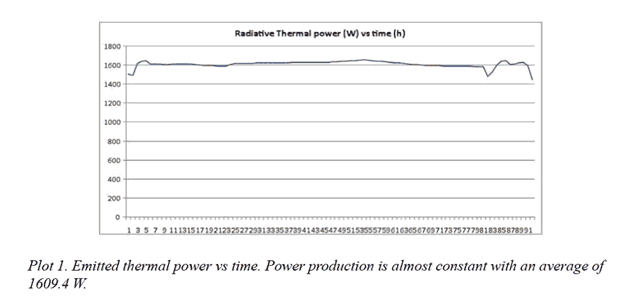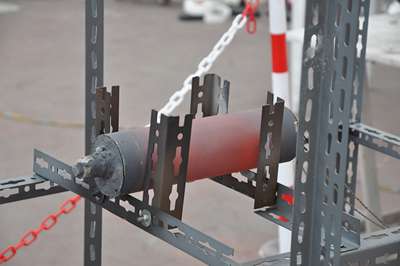Third-Party E-Cat Test Results Published
The debate about whether or not Andrea Rossi's E-Cat technology really works are put to rest with a definitive, third-party test report having been released today stating that at the most conservative, the Hot-Cat technology showed at least a ten-fold increase in power density over what could possibly have been ascribed to any presently-known chemical process.
“Even by the most conservative assumptions as to the errors in the measurements, the result is still one order of magnitude greater than conventional energy sources.” -- Report Abstract “The results obtained indicate that energy was produced in decidedly higher quantities than what may be gained from any conventional source.” -- Report Conclusion
By
Sterling D. Allan
Pure Energy Systems News
The debate about whether or not Andrea Rossi's E-Cat technology really
works should be quieting now, with a very readable, definitive
third-party test report
having been released today, stating that at the most conservative, the
Hot-Cat technology showed at least a ten-fold increase in power density
over what could possibly have been ascribed to any presently-known
chemical processes.
The long-awaited, third-party report on the E-Cat is a single report,
but the report offers two independent studies carried out in December
13-17, 2012 and March 18-23, 2013
in Andrea Rossi's premises in the city of Ferrara in Italy, without the
inventor's involvement.
The first was conducted by Giuseppe Levi, of the University of Bologna,
in collaboration with Evelyn Foschi. The second was conducted by the
previous scientists, joined by Torbjörn Hartman, Bo Höistad, Roland
Pettersson and Lars Tegnér at Uppsala University in collaboration with
the Royal Institute of Technology in Stockholm.
As for credentials,
Hanno Essen used to be chairman of the Swedish Skeptics' Society. He
is one of the scientists who visited Andrea Rossi in 2011 and was
impressed. Here is what he concluded then, according to a Swedish TV
Documentary
made about the E-Cat.

As for the recent testing, reported in this third-party report, the
first test lasted 96 hours continuous, and the second lasted 116 hours
continuous. In both cases, the tests were limited to observe an E-Cat at
high temperature in operation, by measuring the electrical energy input
into the system and the heat produced by the module. And in both tests,
the two E-Cats were provided by Andrea Rossi, and the scientists
conducting the independent tests had no way of opening the reactor to
see what it contained. Rossi was not involved in the testing, other than
being available if they had any questions.
As in the original E-Cat, the reaction is fueled by a mixture of nickel,
hydrogen, and a catalyst,
which is kept as an industrial trade secret.
High-resolution thermal imaging cameras were used to record the heat
inside the reaction tube, with the data recorded on a second-by-second
basis. Electrical power output was measured using a large bandwidth,
three-phase power analyzer.
The report was published at Cornell University's arXiv.org, titled Indication of anomalous heat energy production in a reactor device. At the footer of the home page of arXiv.org is the following statement: (emphasis added)
"arXiv is an e-print service in the fields of physics, mathematics, computer science, quantitative biology, quantitative finance and statistics. Submissions to arXiv must conform to Cornell University academic standards. arXiv is owned and operated by Cornell University, a private not-for-profit educational institution. arXiv is funded by Cornell University Library, the Simons Foundation and by the member institutions."
No significant radioactivity above background radiation was measured
during the tests.
The report refers to the device being tested as the E-Cat HT,
where HT stands for high temperature. Up until now, in all the reporting
that has been done of this technology, we have been colloquially
referring to this as the "Hot-Cat".
In the
interview Frank Ackland of E-CatWorld and I did with Andrea
Rossi on May 7, 2013, here is what he said about this matter.
|
Third-Party Testing of Hot-Cat
|
I would imagine that at least some, if not all, of the professors
involved in conducting that test are now named above in the list of
authors on the report.
Note that a correction to what Rossi said is that there were actually
two tests, not one, with no interruptions.
The tests were funded by Elforsk and Alba Langenskiöld Foundation.
Not Necessarily a Vindication of "Cold Fusion"
Note that scientists do not yet understand the mode of action of how
Andrea Rossi's Energy Catalyzer (E-Cat) works.
"Fusion" is the combining of two elements. Near the end of his life,
Martin Fleishmann bemoaned that he ever called his process "cold
fusion", because he doesn't believe that "fusion" is what is actually
taking place, though the reaction is most likely a nuclear process. The
general phenomenon has been replicated more than 17,000 times according
to Jed Rothwell, author of the industry bedrock website:
http://lenr-canr.org/
Andrea Rossi's technology has been called "cold fusion" by some, but
from what I understand from one of the top scientists working with
Andrea Rossi, Bill Donavan, fusion is not involved at all. It is
all transmutation. The Hydrogen goes to Deuterium
(non-radioactive) through a series of steps, liberating a huge amount of
energy in the process, as the primary transmutation reaction. And the
Nickel goes to Copper (non-radioactive) through a series of steps, as a
low and infrequent secondary transmutation reaction.
That is why LENR, for Low Energy Nuclear Reaction, is a more suitable
name for the class of technology this comes under. "Low Energy", meaning
that in contrast to the sun, where nuclear fusion reactions require tens
of millions of degrees Celsius to take place, these reactions take place
near room temperature.
"Low Energy" does not refer to the output being wimpy. These reactions
could power the energy needs of humans across our planet, cheaply,
safely, and cleanly.
Different from 1 MW Plant
|
|
Note that the Hot-Cat is a research and development variation of the
LENR technology that has been for sale since October 28, 2011 when
Andrea Rossi demonstrated a 1 MW Plant running at half power in
self-sustain mode for more than five and a half hours, which I attended.
(Story)
You can purchase a 1 MW E-Cat plant for producing heat in the range of
103 - 130ºC for $1.5 million USD. (Story)
In his interview with us on May 7, Rossi said that the Hot-Cat runs at
350ºC and is "very stable." At this temperature, he said that creating
electricity will be easy, and that they are making progress on building
such embodiments.
Later in the interview, in response to a question: "Is Andrea Rossi
still working with Siemens to generate electricity?" he replied to the
affirmative, but said that the conditions were under NDA and he was not
at liberty to elaborate.
Ragone Plot of Hot-Cat Energy Density
Where the data really shines is when inserted in a Ragone plot.
Jed Rothwell brought this
chart by Alan
Fletcher to my attention, showing the energy density of the Hot-Cat in
relation to other conventional energy production and storage
technologies. Click on the link or on the image below to get an enlarged
view of the chart.

The official
report
states: "The results obtained place both devices several orders of
magnitude outside the bounds of the Ragone plot region for chemical
sources."
To be more precise, the highest specific energy is Gasoline (which has a
lower peak power), shown at 3x103 Wh/kg. Whereas the specific
energy of the Hot-Cat is shown at 5x107 Wh/kg -- over
four orders of magnitude greater (1700x). And from the peak
power scale, super capacitors (which have a very low specific energy)
are listed at 1x104 W/kg, whereas the Hot-Cat registers at
4x105 W/kg, more than an order of magnitude greater
(40x).
And they add (emphasis mine): "Lastly, it must be remarked that both
tests were terminated by a deliberate shut down of the reactor, not
by fuel exhaustion; thus, the energy densities that were measured
should be considered as lower limits of real values."
Continuous Output
The power output was nearly constant for the duration of the
~100-day testing.

The Report
Here are some excerpts from the report published today at
arXiv.org:
Indication of anomalous heat energy production in a reactor device containing hydrogen loaded nickel powderAbstract:
An experimental investigation of possible anomalous heat
production in a special type of reactor tube named E-Cat HT
is carried out. The reactor tube is charged with a small
amount of hydrogen loaded nickel powder plus some additives.
The reaction is primarily initiated by heat from resistor
coils inside the reactor tube. Measurement of the produced
heat was performed with high-resolution thermal imaging
cameras, recording data every second from the hot reactor
tube.
The measurements of electrical power input were performed with a large bandwidth three-phase power analyzer. Data were collected in two experimental runs lasting 96 and 116 hours, respectively. An anomalous heat production was indicated in both experiments. The 116-hour experiment also included a calibration of the experimental set-up without the active charge present in the E-Cat HT. In this case, no extra heat was generated beyond the expected heat from the electric input. Computed volumetric and gravimetric energy densities were found to be far above those of any known chemical source. Even by the most conservative assumptions as to the errors in the measurements, the result is still one order of magnitude greater than conventional energy sources. Conclusions The two test measurements described in this text were conducted with the same methodology on two different devices: a first prototype, termed E-Cat HT, and a second one, resulting from technological improvements on the first, termed E-Cat HT2. Both have indicated heat production from an unknown reaction primed by heat from resistor coils. The results obtained indicate that energy was produced in decidedly higher quantities than what may be gained from any conventional source. In the March test, about 62 net kWh were produced, with a consumption of about 33 kWh, a power density of about 5.3 · 105, and a density of thermal energy of about 6.1 · 107 Wh/kg. In the December test, about 160 net kWh were produced, with a consumption of 35 kWh, a power density of about 7 · 103 W/kg and a thermal energy density of about 6.8 · 105 Wh/kg. The difference in results between the two tests may be seen in the overestimation of the weight of the charge in the first test (which was comprehensive of the weight of the two metal caps sealing the cylinder), and in the manufacturer’s choice of keeping temperatures under control in the second experiment to enhance the stability of the operating cycle. In any event, the results obtained place both devices several orders of magnitude outside the bounds of the Ragone plot region for chemical sources. Even from the standpoint of a “blind” evaluation of volumetric energy density, if we consider the whole volume of the reactor core and the most conservative figures on energy production, we still get a value of (7.93 ± 0.8) 102 MJ/Liter that is one order of magnitude higher than any conventional source. Lastly, it must be remarked that both tests were terminated by a deliberate shutdown of the reactor, not by fuel exhaustion; thus, the energy densities that were measured should be considered as lower limits of real values. The March test is to be considered an improvement over the one performed in December, in that various problems encountered in the first experiment were addressed and solved in the second one. In the next test experiment, which is expected to start in the summer of 2013, and will last about six months, a long term performance of the E-Cat HT2 will be tested. This test will be crucial for further attempts to unveil the origin of the heat phenomenon observed so far. |
www.pureenergysystems.com
PES Network, Inc.
Copyright © 2003 - 2013
http://pesn.com/2013/05/20/9602320_VINDICATION--3rd-Party-E-Cat_Test-Results-show-at-least-10x-gain/


